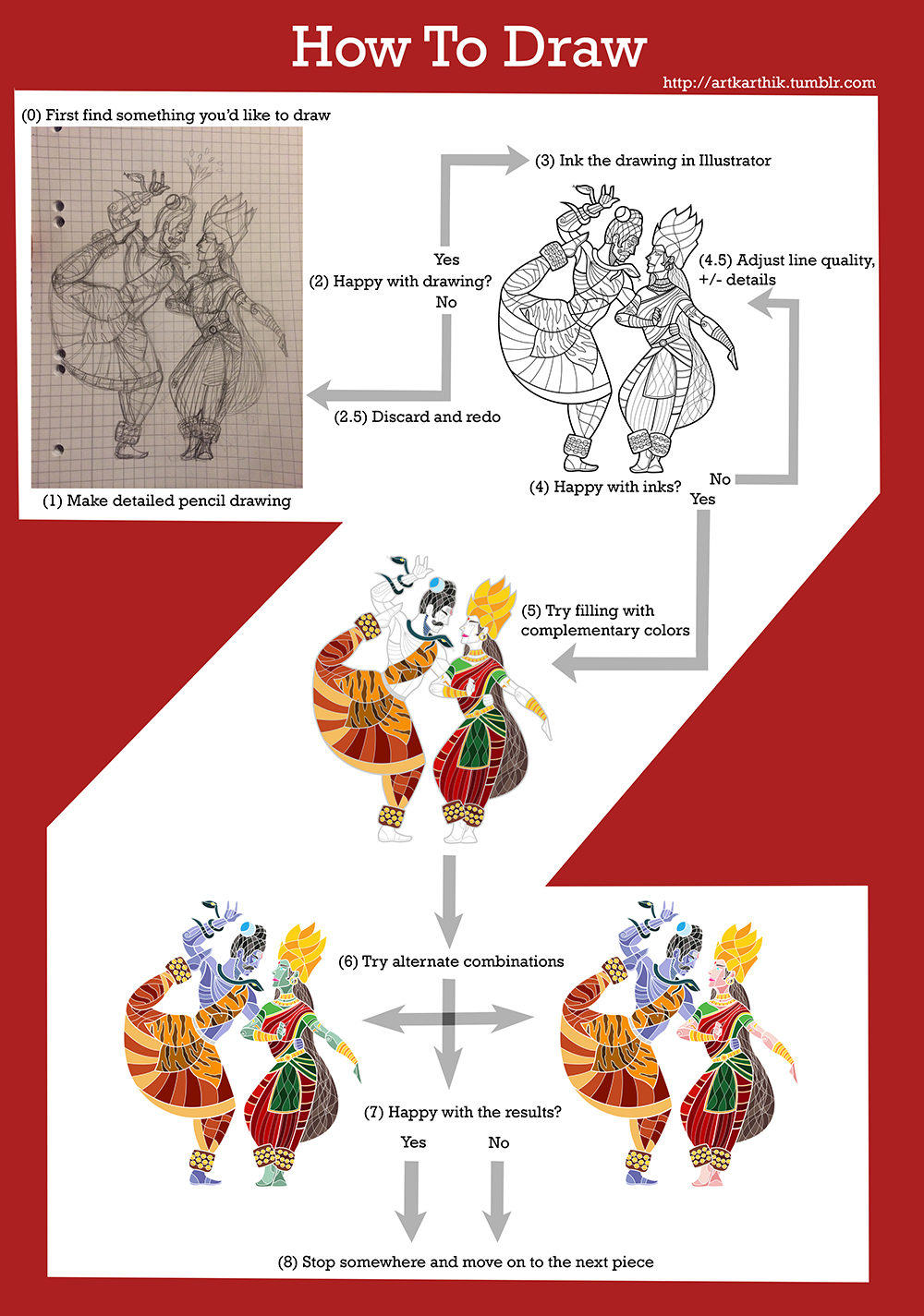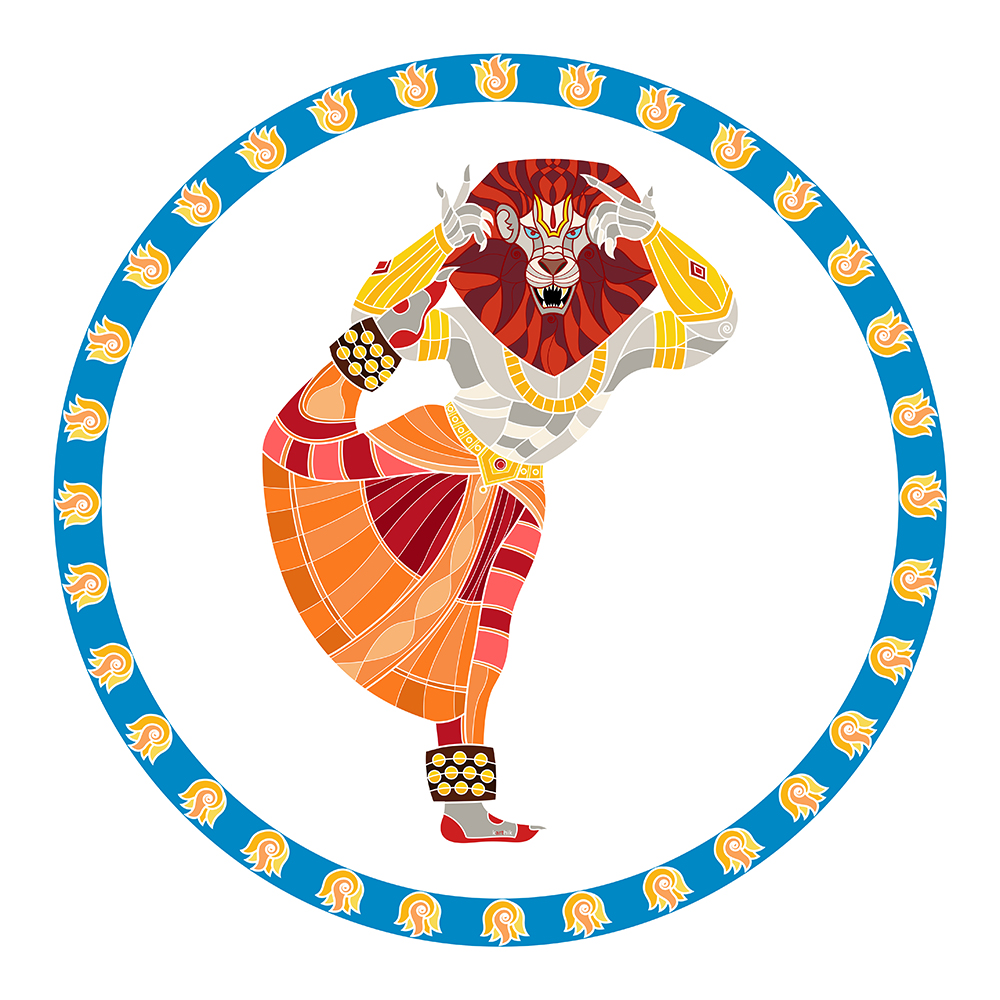Here’s another post in the series of “How did I draw that?”. I have tried combining my neat flowchart skills with my messy drawing style (I’m told it’s a terrible combination). But I hope this sheds some more light on the process :-)
Questions of the Yaksha
During the exile of the Pandava brothers in the forest after their loss in the game of dice, Yudhishtira finds all of his brothers dead/with their spirits trapped next to a lake by a stork who owns the lake. They have been trapped as punishment for drinking water without the stork’s permission.
The stork (which reveals itself to be a Yaksha, a subterranean dweller and hoarder of wealth), then proceeds to ask questions to Yudhishtira about the nature of life, the universe and everything in it (way before the Hitchhiker’s Guide to the Galaxy decided to tackle the subject).
The story often puts Yudhishtira in moral dilemmas where he is often forced to choose between an option which will require him to bend/break the rules and help his family but will make him look bad vs. an option which will require him to follow the rules and hurt his entire family but would make him look good. As a result, we often find him sitting and analyzing the intricacies of what the morally right thing to do is, always fearful of doing something rash instead of taking necessary action.
This incident appears to be the turning point for Yudhishtira where his brothers have been incapacitated and he has to logically come out of the problem on his own. And for the first time in the epic, when forced with a life or death situation, when pushed to act and make a decision, he is able to understand the meaning behind the sufferings his family undergoing, review the events of his life dispassionately, reflect on his duty, gain renewed drive and purpose and solve the problem on his own.
Only in the end does the stork reveal itself to be Yudhishtira’s father Yamadharmaraja, the god of death and justice. This dialogue is called ‘Yaksha Prashna’ or the questions of the Yaksha.
Here are the last three questions that really make you think.
Q: What is the biggest wonder?
A: Day after day countless people die, yet those who remain either believe themselves to be immortal or cannot accept death. What greater wonder can there be?
Q: What is the correct path?
A: Arguments can lead to no certain conclusion. The srutis are all different from one another. There is not even one Rishi whose opinion can be accepted by all. The truth about Dharma and Duty is hidden inside our hearts, therefore that alone is the path that the great have followed.
Q: What is the eternal news?
A: This world full of ignorance is like a pan. The sun is the fire, the days and nights are the fuel. The seasons are the wooden ladle. Time is the cook that is cooking all creatures with these aids. This is the eternal news.
As a design, I chose to show this in contrasting colors of dark purple signifying night with the four brothers trapped as four orange flames, burning and crying out for help at the base of the tree where the stork resides, something that is especially apt considering the last question. The stork with it’s wings spread against the moon is very reminiscent of a Dracula-like figure who is both intelligent and dangerous.
I considered making a drawing with the questions and answers in them, but realized that a lot of the answers are not simple riddles, they are very metaphorical in nature and translating them into appropriate imagery would be quite challenging!
Narasimha & Bharatanatyam
Narasimha is a half-man and half-lion avatar taken by Vishnu to defeat the demon king Hiranyakashipu. The story goes that the demon king had been blessed with a boon that he couldn’t be killed by anything that was born, or any man or any animal, or by any instrument living or dead, in day or night, in the earth or in the sky, indoors or outdoors.
The parameters of the demon king arise at twilight, when Narasimha emerges from a shattered pillar with a terrifying roar in this monstrous form. The creature which is neither man nor animal drags the demon king to the threshold of the house, places him on his lap and tears him apart with his claws.
When going through dance poses from Bharatanatyam, I came across one that seemed to emulate the rage and fury of this avatar perfectly, while also combining the grace and beauty of the dance form itself. My first draft had more oranges and reds, but I wanted to find a subtler way of showing the mood. Hence I settled on an ashen tone for his skin with the violent reds and oranges in his clothes and mane.
Hanuman & Kathakali
The story of the Kalyanasaugandhika from the Mahabharat is set during their 13 year exile in the forests. One day, a beautiful flower with an intoxicating smell wafts on the wind and falls near Draupadi. Fascinated by this flower (called the Kalyanasaugandhika), she asks Bhima to go in that direction and bring back more such flowers. During his travel, Bhima goes through a banana grove where he meets his elder brother Hanuman (the wind god is their common father) and learns a lesson in humility. Bhima then goes on to retrieve the flowers.
When I learned that the Kalyanasaugandhikam was a very popularly depicted story in the Kathakali dance form in Kerala, I realized that this was an excellent opportunity to depict Hanuman himself as the Kathakali performer. The colors are relatively muted when compared with regular Kathakali costumes but they have a charm of their own.
I also discovered that the face paint color in Kathakali is based on the character portrayed.
- Heroic characters use predominantly green in their facepaint (like Krishna or Arjuna).
- A green-red combination is used for a charming or mischievous characters.
- Completely red facepaint with a red beard is used for demons or very fierce characters.
- Hunters and woodsmen are depicted with predominantly black facepaint and a black beard.
- Women usually have yellow/golden facepaint.
- Characters who are noble but have an angry side to them like Shiva or Balarama or Bhima who are depicted with an orange facepaint.
- Characters with dangerous dispositions also have a knife design painted on their face, like a black knife for Yama or a red knife for Ravana.
- Variations occur for characters like Hanuman who is depicted with a white beard which represents very noble characters.



